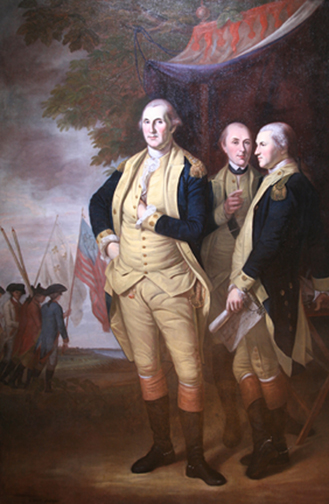
Artist: Charles Willson Peale (1741-1827)
Title: Washington, Lafayette, & Tilghman at Yorktown
Date: 1784
Medium: Oil on canvas
Dimensions: 93 x 64"
Accession number: MSA SC 1545-1120
In October 1781, British General Charles Cornwallis surrendered to General George Washington (1732-1799) at Yorktown, VA, effectively ending the Revolutionary War. In enthusiastic response, the Maryland House of Delegates asked Governor Thomas Sim Lee to commission Maryland-born Charles Willson Peale to paint a portrait of colonial America's hero, General Washington. Lee wrote to Peale in December 1781: "The Honorable Delegates of Maryland have Unanimously resolved to have the Portrait of His Excellency General Washington, at full length, to be placed in their House, in grateful remembrance of that most Illustrious Character." (Letter from Governor Thomas Sim Lee to Charles Willson Peale, December 7, 1781; reprinted in The Selected Papers of Charles Willson Peale and His Family, vol. 1).
Peale, at that time residing in Philadelphia, accepted the commission, anticipating it would increase his artistic stature and likely lead to further public commissions. It took the artist about three years to complete the portrait, as he wished to make it "something better than a mere Coppy [sic]" (Letter from Charles Willson Peale to Samuel Chase, November 23, 1784; reprinted in The Selected Papers of Charles Willson Peale and His Family, vol. 1).
In the end, Peale produced a large-scale painting that exceeded the delegates' request. In addition to painting Washington, whose likeness Peale based on a 1783 sitting that took place in Philadelphia, Peale added two figures to the foreground of his composition. The first, to Washington's immediate left, is the Marquis de Lafayette, who represents the pivotal alliance between colonial America and France that led to victory in the Revolution. Peale initially relied on a bust of Lafayette to produce the latter's painted image, although Lafayette saw the painting as it was nearly finished, and offered to sit for Peale so the artist could tweak his likeness. The second figure Peale added is Lieutenant Colonel Tench Tilghman (1744-1786), a Marylander who served as Washington's military secretary and aide-de-camp, who is shown in profile. Tilghman's portrait was painted from life.
Tilghman's inclusion in the scene was appropriate for a painting that was intended to hang in Maryland. Born in Talbot County, Tilghman studied in Philadelphia and began a career there as a businessman. In 1776, he volunteered his services to George Washington and became his military secretary and aide-de-camp. Tilghman served without pay until May 1781 when Washington was able to arrange for him a regular commission in the Continental Army. Washington called Tilghman a "zealous Servant and slave to the public, and a faithful assistant to me for near five years." (Papers of George Washington, Letter to Sullivan, May 11, 1781). To reward Tilghman's service, Washington sent him to deliver formally the news of Cornwallis' surrender to the Continental Congress, which then was meeting at Independence Hall in Philadelphia. Appropriately, Peale painted Tilghman with the 1781 Yorktown Articles of Capitulation in his left hand. In addition, Tilghman is portrayed wearing his ceremonial officer's sword. Peale painted the sword faithfully, as a careful comparison with the original (also on exhibit in the Senate Committee Room of the Maryland State House) demonstrates.
The portrait setting includes important historical details. The background shows Yorktown from the southeast. In the left middle ground are soldiers of various nationalities carrying flags. On the far left is a French soldier, holding the royal Bourbon flag of France, with its white field and fleur-de-lis. In the center of the group are two British soldiers with their flags cased. To the right is an American soldier holding the regimental standard, identifiable with its red and white stripes and a blue field on which is painted an American eagle. As Peale described the setting:
"I have made in the distance a View of York & Gloster with the British army surrendering in the order in which it happened. And in the middle distance I have introduced French & American officers with Colours of their nations displayed, between them the British with their Colours cased. These figures seem to tell the story at first sight, which the more distant could not so readily do" (Letter from Charles Willson Peale to William Paca, September 7, 1784; reprinted in The Selected Papers of Charles Willson Peale and His Family, Vol. 1)Upon nearing the completion of the painting, Peale wrote to then Governor William Paca in September 1784, reporting on his progress and appealing to the governor to compensate him for painting the three full-length figures. The legislature agreed to Peale's request, paying him £213.4.8 for both the painting and its frame, which Peale designed and Annapolis cabinetmakers John Shaw and Archibald Chisholm assembled. The artist traveled from Philadelphia to deliver the painting to the State House in December 1784.
Additional information about the painting:
"'Something better than a mere coppy' Charles Willson Peale's portrait of George Washington for the Maryland State House" by Elaine Rice Bachmann, The Magazine Antiques, February 2007
